- Home
- Gerald Durrell
The New Noah Page 9
The New Noah Read online
Page 9
The little creatures measure about six inches long and are completely clad in thick soft golden-brown fur, that makes them look more like tiny toy teddy bears. Their long, prehensile tail is also thickly covered. The soles of their hind feet, which are bright pink in colour, are slightly cupped, so that when the creatures scramble about the branches their feet fit round the twigs and give the ant-eater an excellent grip. When a pygmy ant-eater is holding on with his hind feet and his tail, it is almost impossible to pull it off the branch without seriously hurting it. Like its relatives, its forefeet are short and very powerful and are armed with three curved claws, a big one in the centre and two small ones on each side. The palm of its paw is like a small pink cushion and, when it grips with its front feet, the long claws snap down on to the palm with tremendous strength, rather like a blade of a pocket-knife fitting into the slot.
These little animals have a very curious habit which has earned them the name among the natives of Guiana of ‘Tank ’e God’. When asleep, the creature sits clasping the branch with its hind feet and tail wound round tightly, sitting upright like a guardsman, with its two front paws raised heavenwards. If it is disturbed in any way, it will fall forwards on its enemy and the two large claws on its front paws will slash and rip its assailant. The ant-eater will also adopt this odd position when it is frightened, and will squat there for sometimes as long as half an hour, its paws raised high above its head, its eyes closed, waiting for an opportunity to attack.
The little ant-eater was extremely slow and sleepy in his movements and seemed so resigned to his capture that I did not even have to put him in a box, but just leant the twig he was sitting on in the bows of the canoe, and he stood there very stiffly and upright, like a figurehead on an old ship, and remained without moving until we reached our camp. I was not at all sure what sort of food the little fellow would eat, but I knew from books that this tiny animal lives on the nectar of various forest flowers. So the first evening, I mixed up a solution of honey and water, and hung a little pot of it in the ant-eater’s cage.
About eight o’clock that evening, he started to show signs of life. He got down from his stiff, upright attitude and started to crawl in among the branches in his cage in a slow and cautious manner: he was like an old man on a slippery road. Then he discovered the pot of honey. He was hanging on the bars just below it and he sniffed it very carefully with his short pink nose and then decided that it probably contained something worth eating. Before I could stop him, he had hooked a claw over the edge of the little dish and tipped it up, and the next moment he was covered in a shower of honey and water. He was extremely indignant about this, and even more irritated when I had to take him out of the cage and mop him up with a piece of cotton-wool; for the rest of the evening he sat on a branch, cleaning off the sticky remains from his fur.
He enjoyed honey and water very much, but I had to give it to him in a pot with a very small mouth, otherwise he would dip his whole head into it and then climb down on to the floor and wander about, so that by the time morning came, he looked like a moving ball of sticky sawdust.
Honey and water, however, did not give the little animal sufficient nourishment, and so I tried him on some ants’ eggs. To my surprise, he firmly refused to eat these; then I tried him with the ants themselves, and he appeared to be even less interested in them than he was in their eggs. Eventually, more by mistake than anything else, I discovered that he liked grasshoppers and moths, and he would pursue these round his cage with great vigour every evening.
The ant-eaters of Guiana are certainly not the easiest of animals to keep in captivity, but they are very fascinating beasts and it is well worth taking some trouble over them.
Toads that have pockets, and other weird beasts
The creeks ran all round the village of Santa Maria, and so to all intents and purposes we were living on an island. The creeks, I found, were full of vast numbers of baby caymans, and I was very anxious to catch a good supply of these. I soon found out that it was not quite as simple as had been the capturing of crocodiles in the Cameroons. For there you wade along the shallow streams and catch them on the sandbanks. The creeks round Santa Maria were far too deep to do this, quite apart from the fact that they were inhabited by other things besides caymans, such as electric eels and a vicious and bloodthirsty fish called the piranha, both of which would make unpleasant bathing companions. So, in order to capture the baby caymans, I had to adapt my method for hunting crocodile to the country I was in.
We had a big canoe and went off down the creeks late one night, taking with us a big torch and a long stick with a cord tied to the end, which terminated in a slip-knot. I sat right up in the bows of the canoe, holding the torch and this stick, while the paddler in the stern propelled us slowly and gently across the dark waters. I soon found that the baby caymans preferred to lie in the places where the weeds were thick on the surface, with just their noses and their bulbous eyes sticking out. As we moved gently along I shone the torch to and fro, over these patches of weed, until eventually I saw the fiery glow of a baby cayman’s eyes some thirty yards away. Using my free hand to signal, I guided the paddler in the stern until we came to the edge of this weed patch and then signalled him to slow down and eventually stop.
Keeping the beam directed into the creature’s eyes, I leant forward, slipped the noose of cord gently over his head, and then, with a quick jerk, pulled him right out of the water and into the boat, where he wriggled and uttered loud indignant snoring grunts. As soon as they heard these protests, all the other baby caymans for miles around started grunting in sympathy, but this proved to be their undoing, for by listening to the direction from which the grunts came, I could tell where the greatest number of them were hiding, and it was not long before I had a bulging sack on the floor of the canoe which wriggled and slithered as the reptiles moved inside. This great quantity of caymans made such a noise that we could not progress any farther, for everything for miles around could hear the canoe coming with all the baby caymans grunting in unison.
One of the strangest inhabitants of this watery world of the creeks was the pipa toad. It is probably one of the most extraordinary amphibians in the world, for it is quite literally a toad with pockets. I caught some of these strange creatures in a small leaf-choked channel leading off one of the big main creeks. They were so very like the messy decomposed leaves that at first sight I did not recognize them as anything living. They measure about five inches long and look rather like very flat leathery brown kites with a leg at each corner. They did not spit and struggle when I picked them up, as most toads and frogs would do, but lay quite limply relying on their resemblance to the dead leaves to protect them.
One of the specimens I caught was a female with eggs, and I was particularly pleased with this, as it gave me a chance to watch the astonishing hatching of the baby toads. When the female lays her eggs, the male presses them into the skin on her back which has grown soft and spongy in order to receive them. So at first sight they look like transparent beads half buried in the brown leathery skin. Gradually the half of the egg that is above the skin hardens and forms little convex lids, so the eggs remain in the mother’s back in this series of pockets and slowly change into tadpoles and then into tiny toads, each one so small that it would take six of them to cover a postage stamp. When the baby toads are ready to hatch, the edge of the eggshell sticking above the skin becomes soft, and, by wriggling and pushing, the little creatures manage to push the lids back, like trapdoors, and then by much exertion they manage to haul themselves out of their strange potholes – like nurseries in their mother’s back.
This big female that I caught in the creek lands spent her time in a big tin can, lying on the surface of the water, quite still, and looking as though she had not only been dead several days, but as though decomposition had already set in. Gradually, I watched the eggs on her back harden into little lids, and then I waited patiently for the baby toads to make their appearance. In actual fact, the
y put off their entry into the world until I was on the homeward voyage and half-way across the Atlantic, when they chose the most awkward time to appear.
It was about midnight, just when I had finished the work and was thinking of retiring to my cabin, that I glanced at the female pipa toad, before switching out the light in the hold, and saw a strange little black twig which appeared to be growing out of her back. On looking closer, I discovered that one of the small lids had been pushed away and this black object was the tiny arm of a baby toad sticking out of his nursery and waving to and fro. As I watched, he managed to get the other arm out and then his head, when he paused for a moment and looked for all the world like a tiny black workman coming out of a manhole in a road.
It took him about four or five minutes to get right out of his nursery and he lay there for some time on her back, apparently exhausted by his efforts. Then he slid off and plopped into the water, where he started to swim around merrily. I waited there patiently, and presently another of the tiny lids was pushed back and a second baby toad started to wave his arm at me.
As I was squatting there, absorbed and fascinated by this extraordinary sight, I was joined by two sailors who, coming down from their watch on the bridge, had seen the light on in the hold and had wondered if there was anything the matter and, if so, whether they could help. They were rather surprised to find me crouching over a tin at that hour of the night and asked what I was doing. I explained the history of the big female pipa toad and how we had caught her in the mysterious creek lands and how, now, the babies were busily hatching out of her back. The two sailors squatted down beside me and watched the arrival of yet another baby toad, and soon they became as fascinated as I.
Presently, the three of us were joined by yet more sailors who had wondered what had happened to their companions. Once more, I told them the tale of the toad with pockets and they too became so intrigued that they sat down to watch the hatching of the toads. When one baby, more weak than the others, took an extra long time to get out of his pocket, the sailors grew very worried and wanted to know if they could help him with the aid of a matchstick, but I explained that the baby toad was so fragile that the matchstick would appear to him like a tree trunk, and however gently we tried a manoeuvre it, it was more than likely to break one of his thread-like arms or legs.
Eventually, when this baby hoisted its toes out of the pocket and fell in an exhausted heap on his mother’s back, there was a general sigh of relief. Dawn had broken before the last of the toads plopped into the water, and we rose from our cramped positions and went down into the kitchens of the ship to see if we could beg an early-morning cup of tea from the cook. But in spite of the fact that we all yawned over our work that day, we agreed it had been well worth sitting up all night to watch the arrival of the baby toads.
The pipa toads were not, of course, the only unusual amphibians to be found in the creek lands. Guiana seemed to have more than its fair share of unusual toads and frogs.
Next to the pipa toads I think the strangest we caught was the paradoxical frog. We first came across evidence of this creature late one night when my friend and I were dredging a small stream to see what we could catch. Presently, my friend called to me and said that he had caught the strangest creature: it looked just like a tadpole, except that it was about six inches long, with a body about the same size as a hen’s egg.
My friend and I had a long argument as to what this peculiar beast could be; he insisted that it must be some kind of fish, as if it were a tadpole it would grow into a giant frog. I was just as certain that it must be a tadpole. It was only after we had argued for some time that I suddenly remembered having read about this weird amphibian, and then I knew that the creature we had captured was the tadpole of the paradoxical frog.
The paradoxical frog’s life history works in the opposite way to an ordinary frog. With a common frog the spawn hatches out into tiny tadpoles, and these grow until, on attaining a certain size, they develop legs, their tail is absorbed, and they crawl out on to dry land as a medium-sized frog. This is one of the most extraordinary things in the world, for the paradoxical frog is bigger when it is a baby than when it is fully grown.
Another curious frog found in this part of South America is the pouched frog. This little beast cares for its young in almost as unusual a way as the pipa toad. The female pouched frog has a long slit in the skin of her back that opens into a sort of pocket; into this the eggs are placed, and the female more or less forgets about them. Inside the pocket the eggs change into tadpoles, the tadpoles grow legs and their tails are absorbed, and when they are ready for the world, the mother thereupon splits the skin down her back, and out pop the babies, each not much larger than the knob on the top of a knitting-needle.
One of the smallest but most powerful amphibians caught by us in Guiana was the poison arrow frog. These are small tree frogs, each measuring perhaps an inch and a half long, and decked out in the most wonderful colours and patterns. There are several species, and they might be red and gold striped on a cream background, or pink and blue on a black background, or any other combination of colours. They are very lovely little things, and a jar full of them looks more like a mass of highly-coloured sweets than live creatures. To the Indian tribes these little frogs are most useful. They catch a number and put them close to a fire. As soon as the frogs start to become hot they exude a kind of slime from their bodies, which the Indians scrape off and collect. This slime, prepared in a special way, is a most potent poison, and the Indians use it to dip the tips of their arrows in. Thus, when the arrow strikes an animal – even a quite powerful one, like a wild pig – the poison works very rapidly and kills the beast. So, for the Indians, each of these little tree frogs is a miniature poison factory in itself, and whenever they need fresh material for their arrows they go off into the forest and collect a number of the frogs from which to manufacture it.
In which Cuthbert the curassow causes trouble
One of the most charming but irritating specimens that I got in Guiana was Cuthbert the curassow. I bought him when I was up in the creeklands, and he started being a nuisance almost immediately. The curassow are large birds, as big as a turkey, with jet black feathers all over their bodies, bright yellow feet and a thick yellow beak. The feathers on the top of their heads stand up and curl forwards in a short crest, and they have large, dark eyes with a mad expression in them.
Cuthbert arrived, being carried by his owner, who was a fat and shy little Chinaman. When I purchased the bird, the Chinaman stooped and placed him on the ground near my feet. He stood there for a minute or two blinking his eyes and uttering a soft plaintive ‘peet-peet-peet’, a noise which was amazing, coming from such a large and fierce-looking bird. I bent down and started to scratch his curly crest and immediately Cuthbert closed his eyes and fell flat on the ground, shaking his wings with delight and giving a sort of throaty crooning noise.
The Chinaman assured me that he was very tame and that I did not need to shut him up in a cage, as he would not wander away. Since Cuthbert seemed to have taken such a fancy to me I decided that this was probably correct. When I left off scratching his head, however, he rose to his feet and walked closely beside my legs, still peeting ridiculously. Very slowly he crept forward until he was close enough, and then he lay down across my shoes, closed his eyes, and started to croon again. He was gentle and so sloppy in his character that there and then I decided to call him Cuthbert, as I felt that this was the only name that really suited him.
On the evening of Cuthbert’s arrival, I was sitting at a small table in our hut, endeavouring to write up my diary, when Cuthbert, who had been wandering thoughtfully about the room, decided that it was time he bestowed a little affection on me. So he flew up on to the table with a great flapping of wings and walked across it, peeting in a pleased tone, and tried to lie down across the paper on which I was writing. I pushed him away irritably, and as he stepped backwards, with a look of outraged astonishment on his face at
such treatment, one of his great chicken-like feet upset the ink, which, needless to say, went all over the diary, so that I had to rewrite two pages of it.
While I was doing this, Cuthbert made several attempts to climb into my lap but I warned him off vigorously, and eventually he wandered away and stood in deep thought for a few minutes. He decided that approaching me in this slow manner was not successful and so he would have to try and take me by surprise. He waited until I was not looking and then took off and tried to fly up on to my shoulder. He missed his mark, of course, and crashed on to the table with outstretched wings, uttering a shrill squawk of dismay, and upsetting the ink for a second time. I left him in no doubt as to how angry I was and so he retreated into a corner of the room and sat there sulking.
Presently my companion came into the hut, in order to perform the nightly task of hanging up the hammocks in which we slept. He pulled them out of the corner where they were stacked, and was busily occupied in disentangling them from their ropes when Cuthbert spotted him and decided that if I would not pay any attention to him, perhaps my companion would. He cautiously crept across the room and then lay down just behind my friend’s feet and closed his eyes.
While my friend was struggling with the ropes and hammocks, he stepped backwards suddenly and tripped over the bird behind him. Cuthbert gave a squawk of alarm and retired to his corner once more. When he thought my friend’s attention was fully occupied, he came out, crept up to him and lay down across his shoes for the second time. The next thing I knew, there was a crash and my companion fell to the floor, together with all the hammocks, and from beneath the tangled mass of mosquito nets, rope, and canvas, Cuthbert’s head peered out, peeting with great indignation at such unmannerly treatment. I made up my mind that he had caused quite enough trouble for one evening, so I took him over to the part of the hut where I kept the animals and tied him with a long cord round his leg to a heavy box and left him there, peeting away vigorously to himself.

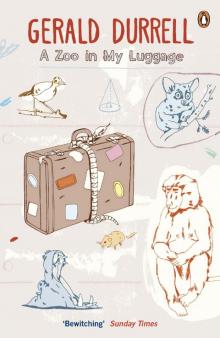 A Zoo in My Luggage
A Zoo in My Luggage The New Noah
The New Noah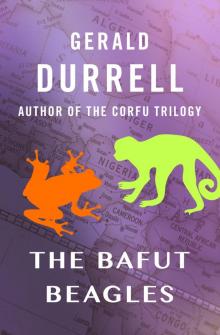 The Bafut Beagles
The Bafut Beagles Encounters With Animals
Encounters With Animals Catch Me a Colobus
Catch Me a Colobus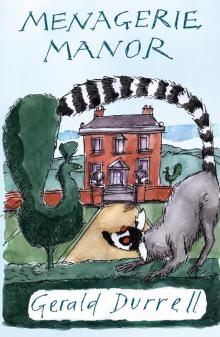 Menagerie Manor
Menagerie Manor The Picnic and Suchlike Pandemonium
The Picnic and Suchlike Pandemonium Ark on the Move
Ark on the Move My Family and Other Animals
My Family and Other Animals Two in the Bush (Bello)
Two in the Bush (Bello) The Stationary Ark
The Stationary Ark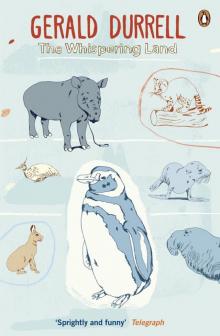 The Whispering Land
The Whispering Land Three Singles to Adventure
Three Singles to Adventure Fillets of Plaice
Fillets of Plaice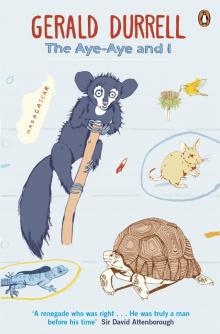 The Aye-Aye and I
The Aye-Aye and I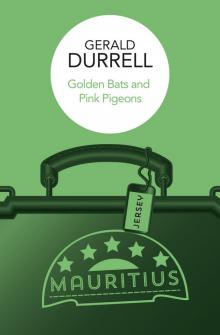 Golden Bats & Pink Pigeons
Golden Bats & Pink Pigeons The Drunken Forest
The Drunken Forest Marrying Off Mother: And Other Stories
Marrying Off Mother: And Other Stories The Corfu Trilogy (the corfu trilogy)
The Corfu Trilogy (the corfu trilogy)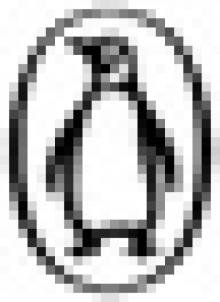 The Corfu Trilogy
The Corfu Trilogy Marrying Off Mother
Marrying Off Mother Two in the Bush
Two in the Bush